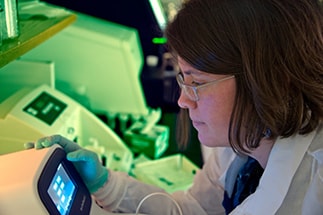Purpose
Learn about the Listeria Initiative, a national surveillance that collects information on laboratory-confirmed cases of listeriosis in the United States.

Improved data collection
In the United States, listeriosis is nationally notifiable, meaning the infections must be reported to local, state, territorial, or federal public health authorities, who monitor the disease and look for signs of an outbreak.
What's collected
The Listeria Initiative is a national surveillance system that collects information on laboratory-confirmed cases of listeriosis in the United States.
Nearly all state health departments and other reporting jurisdictions submit case information to the Listeria Initiative.
Why the data are important
Listeria Initiative data help identify, solve, and stop outbreaks
When a person is diagnosed with listeriosis, a public health investigator interviews them about the foods they ate in the month before they got sick using the Listeria Initiative questionnaire. When investigators identify a group of illnesses with a possible common source, they rapidly compare information on the foods eaten by patients in the possible outbreak with foods eaten by listeriosis patients who are not involved in the possible outbreak.
This comparison gives investigators important clues about possible sources, which helps to solve outbreaks. Without the Listeria Initiative database, appropriate comparison data ("controls") for listeriosis investigations would be difficult to obtain, and outbreaks would take longer to solve and stop.
The Listeria Initiative also incorporates molecular subtyping data ("fingerprinting") from clinical, food, and environmental isolates, or samples, of Listeria to identify clusters of possibly related cases. Laboratories subtype isolates using pulsed-field gel electrophoresis (PFGE, a type of DNA fingerprinting) and submit the results to PulseNet, the National Molecular Subtyping Network for Foodborne Disease Surveillance. Since 2013, laboratories also examine Listeria isolates using whole genome sequencing. Whole genome sequencing is a process that uses laboratory methods to determine the complete DNA sequence of an organism's genome.
How we work to improve
Whole genome sequencing improves the detection and investigation of foodborne outbreaks
Whole genome sequencing is an important tool for disease detectives. It provides genetic information about germs that are making people sick. This information improves our ability to detect, investigate, and stop foodborne outbreaks.
With whole genome sequencing, Listeria outbreaks can be detected when as few as two people have gotten sick. Determining that the same strain of Listeria is making people sick is an indication that these illnesses may have come from the same source – for example, the same contaminated food or the same contaminated food processing facility. Thus, whole genome sequencing can help disease detectives solve outbreaks.
By combining real-time whole genome sequencing with data from patients about the foods they ate and data about Listeria in foods, public health officials can:
- Detect more clusters (possible outbreaks) of Listeria infections
- Link cases of Listeria to a likely source
- Identify unrecognized sources of Listeria
- Stop Listeria outbreaks while they are still small
Moving into the future
Whole genome sequencing alone cannot solve outbreaks, but it has dramatically improved our ability to track Listeria and other germs. Epidemiologic data, such as information about what foods people ate before they got sick, are critical for outbreak investigations. Our ability to solve outbreaks caused by Listeria and other germs will improve as we obtain more epidemiologic data, and thus strengthen the link between epidemiologic and whole genome sequencing data.
